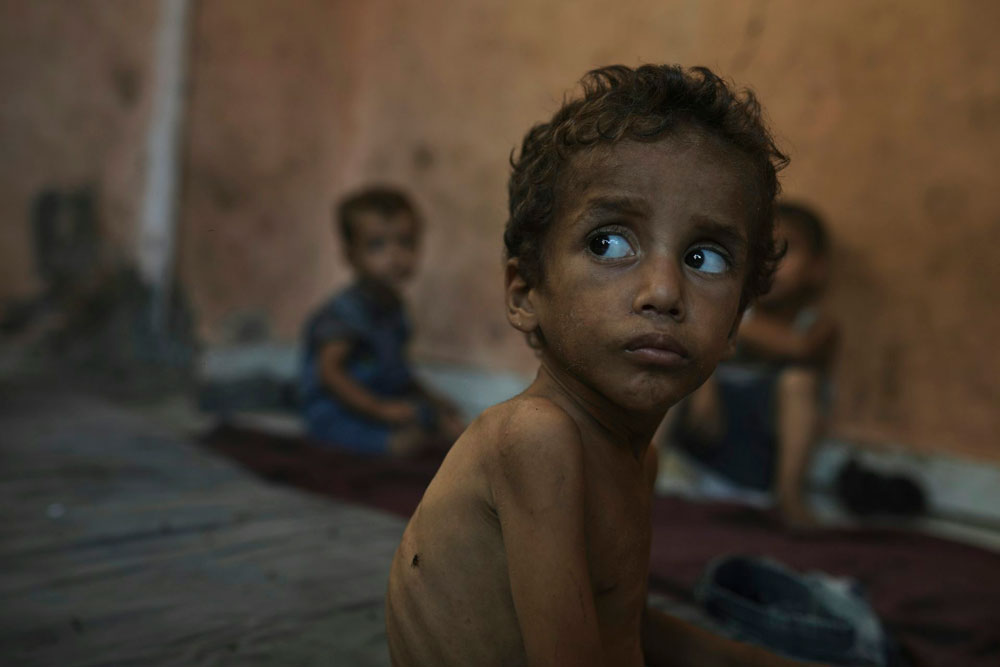
By Rosalyn R. LaPier
There is increasing evidence that “widespread starvation, malnutrition and disease” are driving a rise in hunger-related deaths“ in Gaza, a group of United Nations and aid organizations have repeatedly warned.
A July 29, 2025, alert by the Integrated Food Security Phase Classification, a global initiative for improving food security and nutrition, reported that the “worst-case scenario of famine is currently playing out in the Gaza Strip,” as access to food and other essential items is dropping to an “unprecedented level.”
More than 500,000 Palestinians, one-fourth of Gaza’s population, are experiencing famine, the U.N. stated. And all 320,000 children under age 5 are “at risk of acute malnutrition, with serious lifelong physical and mental health consequences.”
U.N. experts have accused Israel of using starvation “as a savage weapon of war and constitutes crime under international law.”
They are calling on Israel to urgently “restore the UN humanitarian system in Gaza.”
Israel is not the only government in history to cut off access to food and water as a tool of war. As an Indigenous scholar who studies Indigenous history, I know that countries – including the United States and Canada – have used starvation to conquer Indigenous peoples and acquire their land. As a descendant of ancestors who endured forced starvation by the U.S. government, I also know of its enduring consequences.
Dismantling Indigenous food systems
From the founding of the U.S. and Canada through the 20th century, settler colonizers often tried to destroy Indigenous communities’ access to food, whether it was their farms and livestock or their ability to access land with wild animals – with the ultimate aim of forcing them off the land.
In 1791, President George Washington ordered Secretary of War Henry Knox to destroy farms and livestock of the Wea Tribe that lived along the Ohio River valley – a fertile area with a long history of growing corn, beans, squash and other fruits and vegetables.
Knox burned down their “corn fields, uprooted vegetable gardens, chopped down apple orchards, reduced every house to ash, [and] killed the Indians who attempted to escape,” historian Susan Sleeper-Smith noted in her 2018 book, “Indigenous Prosperity and American Conquest.” Women and children were taken hostage. The goal was to destroy villages and farms so that Indigenous people would leave and not return.
Seventy-two years later, General Kit Carson conducted a scorched-earth campaign to remove the Navajo from what is now Arizona and New Mexico. Similar to Knox, he destroyed their villages, crops and water supply, killed their livestock and chopped down over 4,000 peach trees. The U.S. military forced over 10,000 Navajo to leave their homeland.
Indigenous famine
By the late 19th century, numerous famines struck Indigenous communities in both the U.S. and Canada due to the “targeted, swift, wholesale destruction” of bison by settlers, according to historian Dan Flores; this, too, was done in an effort to acquire more Indigenous land. One U.S. military colonel stated at the time: “Kill every buffalo you can! Every buffalo dead is an Indian gone.”
There were an estimated 60 million bison before U.S. and Canadian settlement; by the 1890s, there were fewer than 1,000. Indigenous communities on the northern Great Plains in both the U.S. and Canada, who believed bison were a sacred animal and who relied on them for food, clothing and other daily needs, now had nothing to eat.
Historian James Daschuk revealed in his 2013 book, “Clearing the Plains: Disease, Politics of Starvation, and the Loss of Aboriginal Life,” that between 1878 to 1880, Canadian Prime Minister Sir John A. Macdonald did little to stop a multiyear famine on the Canadian Plains, in what is now Manitoba, Saskatchewan and Alberta. Macdonald did not hide his intentions. He and his government, he said, were “doing all we can, by refusing food until the Indians are on the verge of starvation.”
Indigenous peoples on the Canadian Plains were forced to eat their dogs, horses, the carcasses of poisoned wolves and even their own moccasins. All the Indigenous peoples in the region – an estimated 26,500 people – suffered from the famine. Hundreds died from starvation and disease.
Malcolm C. Cameron, a House of Commons member at the time, accused his government of using “a policy of submission shaped by a policy of starvation” against Indigenous peoples. His denunciation did little to change their policy.
What my great-grandparents experienced
Many Indigenous peoples’ families in the U.S. and Canada have stories of surviving forced starvation by the government. Mine does, too.
In the winter of 1883-1884, my grandmother and grandfather’s parents experienced what is remembered as the “starvation winter” on the Blackfeet reservation in what is now Montana.
Similar to what happened in Canada, the near extinction of bison by American settlers led to a famine on the Blackfeet reservation. In an effort to slow the famine, Blackfeet leaders purchased food with their own money, but the U.S. government supply system delayed its arrival, creating a dire situation. Blackfeet leaders documented 600 deaths by starvation that one winter, while the U.S. government documented half that amount.
As historian John Ewers noted, the nearby “well-fed settlers” did nothing and did not offer “any effective aid to the Blackfeet.”
My family survived because a few men and women within our family were able to travel far off the reservation by horseback to hunt and harvest Native foods. I was told the story of the “starvation winter” my entire life, as were most Blackfeet. And I now share these stories with my own children.
Weapon of war
Thousands of children in Gaza are malnourished and dying of hunger-related causes.
Due to mounting international pressure, Israel is pausing its attacks in some parts of Gaza for a few hours each day to allow for some aid, but experts have noted it is not enough.
“We’re talking about 2 million people. It’s not 100 trucks or a pausing or a few hours of calm that is going to meet the needs of a population that has been starved for months,” Oxfam official Bushra Khalidi told The New York Times.
“This is no longer a looming hunger crisis – this is starvation, pure and simple,” Ramesh Rajasingham, director of the U.N.’s Office for the Coordination of Humanitarian Affairs, said on Aug. 10, 2025.
Many might assume that the use of starvation as a weapon of war happened only in the past. Yet, in places like Gaza, it is happening now.
![]()
Rosalyn R. LaPier is Professor of History at the University of Illinois at Urbana-Champaign.





























Samuel L. Bronkowitz says
I personally find it frustrating that so many people treat politics like a sport. I know there are several reasons for this, the main one probably being the fact that their vote doesn’t fundamentally affect them, e.g. they’re retired and set, or they’re poor and scraping for food as it is already. There’s also the fact that news organizations realized that viewership explodes if you treat something like a sport and keep the suspense up, but what this does is to detach people from the actual consequences of their voting decisions.
So when people set basic requirements for a candidate, like expecting them to have values that align with theirs or support things that they do, these sports teams fans scream and cry and cajole about voting for the team. You get a party rallying behind child rapists, or child rape defenders, or candidates that they refused to let their constituents choose, or ones so addled with mental decline that they need diapers. But it’s the team, remember? Vote for the team, not the candidate, they cry.
This is what you get when you vote for the team. By holding your nose and voting for the lesser evil, you are *committing an evil act yourself*. You are choosing evil. You get elected officials that think chemtrails are real, vaccines cause disease, the world is flat, and they make real decisions that have real consequences.
And yet these same people will shrug and say what can you do, and go back to arguing on the comments section of a blog or twitter or facebook, posting memes about the other team, and think wow why are things so expensive now? And shake their heads, sigh, and continue to do evil for their team.
Stop treating politics like a sport.
Pogo says
@Dear Rosalyn,
We must be patient and wait our turn; there will be destitution and famine for all. Meanwhile, why not write something inspiring about the electric AI world of the future — and the machines’ migration to the rest of the cosmos.
A human being should be able to change a diaper, plan an invasion, butcher a hog, conn a ship, design a building, write a sonnet, balance accounts, build a wall, set a bone, comfort the dying, take orders, give orders, cooperate, act alone, solve equations, analyze a new problem, pitch manure, program a computer, cook a tasty meal, fight efficiently, die gallantly. Specialization is for insects.
— Robert A. Heinlein
Do you grok baby?
https://www.bing.com/search?q=Do+you+grok+baby
Kennan says
Who are we? What have we become? Are we all allergic to the obvious? We are” flat earthers” on the international stage. We are directed by Israel and we use our power to ignore everyone, as we continue to fund the Holocaust we say we don’t want.
The days following the October 7, 2023 attack Israel implemented a starvation campaign in Gaza by turning off electric and water. Soon thereafter, the Israeli defense forces began to bomb everything, everywhere, killing everyone.
Israel told the fictitious tale of Hamas fighters hiding under hospitals all over Gaza. A lie. A lie to justify the killing of civilians all over Gaza. Men, women and children mostly. Civilians moved around Gaza in a.” musical chair, game of death.”
Israel has run America’s foreign policy fully since 1967 when the official occupation began.
All condemn, and none deny the terrorist acts of October 7, 2023. A militant terrorist group like Hamas was met by a wide spread attack on civilians by the most advanced, nuclear capable military in the Middle East. The outcome was never in doubt, and falsely calling it, a war would lay the groundwork for the purposely collateral holocaust to come. turning water and electric off was a war crime on day one. A war crime in a territory, you already own an occupy.
We see the glaring technicolor starvation now so fully because it has been cultivated for almost 2 years.
Benjamin Netanyahu and the IDF showed in no uncertain terms that they could pinpoint and kill almost any Hamas member they wanted, whether it be in Iran, Lebanon, Syria, Iraq, or any anywhere else in the Middle East quite frankly.
The support, relish, and glee the United States has taken in funneling billions of dollars in weapons and cash to kill. Arabs is staggering. Holocaust in plain sight. The exchange rate for human life if you are an Arab and./or a child just isn’t very good.
What will it take? Will it take the leaked audio recordings on Friday, August 15, 2025. Remarks by Israel’s former military intelligence chief made about the price he believed Palestinians should pay for Hamas’s October 7 attack. The tape recordings, aired by Israel’s channel 12 TV, captured former major general Auron Haliva saying in Hebrew,” the fact that there are already 50,000 dead in Gaza is necessary and required for future generations”. He went further saying that for every Israeli killed on October 7, 50 Palestinians.(that had nothing to do with it) should die.
“ it doesn’t matter if their children. I’m not speaking out of revenge. I’m talking about a message for future generations. From time to time, they need a NAKBA (catastrophe) to feel the cost,” Haliva said.
The NAKBA was the mass displacement of 750,000 Palestinians in 1948 to Garner the” birth of Israel”.
What will it take? Will it take Benjamin Netanyahu telling the times of Israel, “ I want a greater Israel. I will never allow Palestine estate.”
What will it take? Will it take former Green Beret Anthony Aguilar blowing the whistle on the Gaza humanitarian foundation. Aguilar will tell the story of IDF soldiers, Mossad members, US mercenaries all taking shots at civilians in a panic running for food and killing them. Will it take the understanding that about 100 Palestinians are killed a day at or near these” so-called” humanitarian sites.
What will it take? Will it take the well over 100,000 Gazans killed, mostly children riddled with bullet holes, limbs blown off, and several thousand younger than one year-old. Will it take the understanding that more than 250 journalists have been murdered in Gaza, every hospital bombed, every refugee camp, almost every school, every mosque, and even visibly marked ambulances, trying to pick up the injured and dying.
Israel is now the 21st-century version of the Nazis, and if they are Nazis, then the US is the SS. Total financial support and permission for Israel to continue to walk away from the negotiating table, even when Hamas was willing to let all the hostages go. Often, Israel did this at the 11th hour.
Israel is in talks with five countries – Indonesia, Somaliland, Uganda, South Sudan, and Libya about the potential settlement of Palestinians from Gaza. South Sudan.???!!! Forced settlement and ethnic cleansing in real time. War torn countries in their own right that are having trouble sustaining themselves!
I could go on and on, and on and on. All this real time factual in your face genocidal ideological propaganda painfully exposes Israel’s evil. One must remember there are hundreds of thousands of Jews that don’t support this. There is a decided difference between a Jew, an Israeli, and of course, a Zionist. Zionists are evil. Full stop. Israel, unfortunately, has enjoyed their nationalistic existence a top the bodies, corpses, and skulls of many a dead Arab. That is a fact. Now it has reached its zenith with no guard rail in sight.
I have become very tired of Israeli apologists, both at home and abroad with nothing more than an apple pie full of manufactured consent.
Gaza and its blood is what will make the United States the second biggest pariah in the world, and a country no one will trust…. Not even Americans. This is sad. Those who continue to support this will continue to throw the.” antisemite Hail Mary” in everyone’s face that disagrees with them. They use the holocaust as a way to hyper victimize themselves. Bypassing all they are doing now. Talking about October 7, as if nothing happened after that. Doing all this killing on the heels of a holocaust, their parents and grandparents suffered from. No doubt in my mind, holocaust survivors, those who have passed, and those still alive would be ashamed of this.
Antisemitism? October 7? That’s what you’re going with?